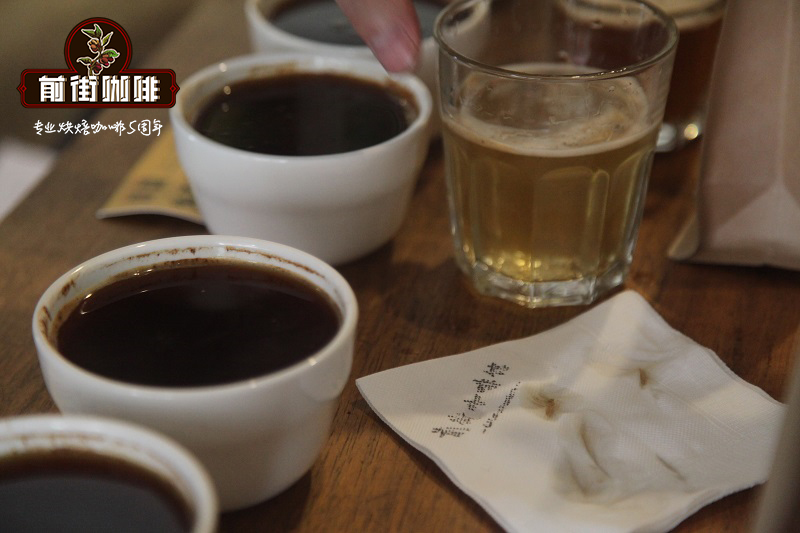Bolivian Java Coffee beans introduce the difference between Bolivian Rose Summer and Java Coffee

Professional coffee knowledge exchange more coffee bean information please follow the coffee workshop (Wechat official account cafe_style)
Long beans that can compete with Rose Summer: Bolivian Java Coffee beans
The variety known locally in Bolivia as long-shaped beans is named because of its long appearance. Its official name should be Bolivia's Java. Java is a very interesting bean species, which is strongly related to Indonesia. But in fact, Java was first born in Ethiopia's primeval forest coffee tree species, collected by the local people, and then spread to Indonesia through Yemen, where it was named Java. It was generally thought that Java was a branch of Tibica, but after genetic comparison, it was found that Java is actually a coffee variety Abysinia from Ethiopia.
After Indonesia, Java, Bolivia, first spread to the nearby Timor island group, and then to Cameroon in East Africa, where it was first released for farmers in 1980. As for the spread to Central and South America, it was introduced to Costa Rica through CIRAD (the Centre de Coop é Internationale en Recherche Agronomique pour le D é veloppement) in 1991 under the guidance of breeding expert Benoit Bertrand. The first Central American country to formally recognize Java beans was Panama in 2016, while Bolivia was introduced through Nicaragua.
As the name suggests, long beans have long fruits and seeds, brass buds, high plants but low yields. Due to its outstanding flavor, it is as resistant to leaf rust and coffee fruit disease as Bolivian rose coffee beans, so it is very suitable for small farmers.
Drop Coffee's chief bean baker Joanna Alm, Head roaster, describes her impression of Bolivia like this: "from the very beginning, I have to admit that I have fallen in love with Bolivia, where the people, the country, and coffee, the high elevations of Bolivia, such as Alassita, are as high as 1580 meters, the breathtaking natural scenery, the history of growing coffee, and the clean flavor of coffee. "
In fact, she wrote a very long blog on the Drop Coffee website about what she knew about Bolivia. In order to convey her enthusiasm and preserve her original appearance, most of the following text was compiled from her article, and a small part of the live part about the manor came from the supplement and revision of "Baker". Interested friends can find out the original text and refer to it for reference.
Bolivia has a very interesting history, although it is a country with great potential for coffee exports, its production has been quite scarce and the conditions for growing coffee are excellent, but the challenges are also extremely difficult. the result is an extraordinarily rich agricultural history built on a very difficult land.
In 1991, the government promoted a plan for indigenous people to grow coffee, but paid little attention to quality. In 2004, when the Cup of Excellence arrived in Bolivia, the bean baker finally had a chance to find the once hard-to-find Bolivian coffee.
The main problem for coffee farmers has always been that it is difficult for them to earn enough money to support the long-term cultivation of coffee. In order to subsidize the shortage of coffee, they have to grow other crops, mainly coca, which can be used to make cocaine, and it is legal to grow coca in Bolivia. Encouraged by the government, coca leaves are four times as profitable as coffee and much easier than growing coffee, causing many farmers to abandon coffee or even give up farms altogether.
The cultivation of coca requires the use of a large number of chemical pesticides and fertilizers, which do great damage to the soil. In other words, after several years of planting coca, the soil becomes barren and can no longer grow any crops. In early 2000, the United States strongly supported Bolivian agriculture, but coffee farmers suffered the most because the Bolivian government later supported coca cultivation and relations with the United States deteriorated. Then, with the resumption of a limited anti-drug war in Bolivia, a number of programs were restarted to assist coffee farmers, such as the extraordinary Cup, which was held with the support of USAID.
As if these blows were not enough, when leaf rust hit in 2013 (a mold that attacks coffee leaves, making it impossible for coffee trees to photosynthesize), Bolivia lost 50% of its coffee production in that year alone. Combined with the government's coca leaf policy and leaf rust, Bolivia's coffee production has fallen by 70% over the past decade, making it a small coffee-producing country.
This means that if you want to find the best coffee in Bolivia, such as Bolivian rosette beans, you have to pay a higher price than other producing areas, but this is not necessarily a bad thing, scarce production and the world's demand for high-quality coffee. Bolivian coffee farmers are in a favorable position for the first time.
Drop is very excited about the flavor spectrum of Bolivian rose summer coffee beans. The high sweetness and delicious chocolate flavor are combined into a very special cup of coffee. In order to highlight the delicacy that Bolivian coffee can create, the Rodriguez family family has grown quite special varieties: Bolivia Rosa (Geisha) and Java (Java).
The Rodrigo family owns a washing plant, Buena Vista Mill, which handles cherries sent by farmers in Caranarvi and Sud Yungas, and then packages them for export. for three decades, they have been looking for coffee from small coffee farmers. But when production continues to decline, their export business is also on the verge of crisis, and if even Rodrigo cannot support it, Bolivian coffee may even disappear in the future.
To meet the severe challenge, the Rodrigo family decided to grow their own coffee five years ago.
In 2012, the Rodrigo family began to buy a lot of farmland in the province of Caranavi, located 150km north of La Paz, Bolivia's largest city, with particularly fertile soil and high altitude, and has always been regarded as the center of Bolivian boutique coffee production. Rodrigo aims to create demonstration farms, using his own farms to demonstrate how to farm, educate other coffee farmers on sustainable farming, and increase the output of his own treatment plants. Not only that, they introduced a model of sustainable development for coffee farmers: sustainable economy, social understanding and environmental awareness, which they named the "Sol de Ma ñ ana". In five years, Rodrigo now has 12 farms, with the goal of expanding the acreage to 200 hectares.
Under the Chaoyang Project, La Linda Farm is Rodrigo's first farm, established in 2012 and can be said to be the leader of the whole project. The farm covers an area of only 10 hectares, of which 8 hectares grow coffee and ushered in its first harvest in 2015. In addition to Kaddura and Typica, some fairly rare beans are also grown, including Bolivian rose, San Bernardo, SL-28, and long beans (Longberry) from Ethiopia.
In Bolivia, the local variety known as long bean (longberry), officially known as Bolivia Java, because the bean appearance is quite long, similar to the rose summer, the flavor is also a rare variety that can compete with the Bolivian rose summer.
Important Notice :
前街咖啡 FrontStreet Coffee has moved to new addredd:
FrontStreet Coffee Address: 315,Donghua East Road,GuangZhou
Tel:020 38364473
- Prev

How about Bolivian Java coffee? description of the flavor characteristics of Bolivian Java coffee
Professional coffee knowledge exchange more coffee bean information please follow the coffee workshop (Wechat official account cafe_style) if in many coffee producing areas, to find such a romantic, beautiful and dangerous dream territory, it is Bolivia! Pedro/Agricafe has been growing coffee in Bolivia for 30 years, which can be said to have witnessed the cultivation / production of coffee in Bolivia.
- Next

Introduction to the coffee beans and flavor characteristics of Galapagos Alcatraz coffee beans in Ecuador
Professional coffee knowledge exchange more coffee bean information please follow the coffee workshop (Wechat official account cafe_style) Ecuadorian coffee coffee: Ecuador is an island country in South America, coffee cultivation has a long history, about the beginning of the 19th century, Ecuador coffee compared to bananas, oil, shrimp and so on was never listed as a major source of income, but there are enough mountains on the island.
Related
- Detailed explanation of Jadeite planting Land in Panamanian Jadeite Manor introduction to the grading system of Jadeite competitive bidding, Red bid, Green bid and Rose Summer
- Story of Coffee planting in Brenka region of Costa Rica Stonehenge Manor anaerobic heavy honey treatment of flavor mouth
- What's on the barrel of Blue Mountain Coffee beans?
- Can American coffee also pull flowers? How to use hot American style to pull out a good-looking pattern?
- Can you make a cold extract with coffee beans? What is the right proportion for cold-extracted coffee formula?
- Indonesian PWN Gold Mandrine Coffee Origin Features Flavor How to Chong? Mandolin coffee is American.
- A brief introduction to the flavor characteristics of Brazilian yellow bourbon coffee beans
- What is the effect of different water quality on the flavor of cold-extracted coffee? What kind of water is best for brewing coffee?
- Why do you think of Rose Summer whenever you mention Panamanian coffee?
- Introduction to the characteristics of authentic blue mountain coffee bean producing areas? What is the CIB Coffee Authority in Jamaica?

